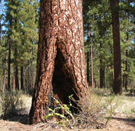Protecting Communities And Saving Forests
Bonnicksen, Thomas M. Protecting Communities And Saving Forests–Solving the Wildfire Crisis Through Restoration Forestry. 2007. Published by the Forest Foundation [here].
Full Text and additional Restoration Forestry information [here]
Selected excerpts:
Restoration forestry is a vision for the future rooted in respect for the past. Thus, restoration forestry uses the historic forest as a model for the future forest. No scientist, forester, or environmental activist could conceive of more beautiful or diverse and sustainable forests, with more wildlife, than those found by the first European explorers. Restoration forestry aims to recover our nation’s forest heritage while also restoring the productive and harmonious relationship between people and forests that existed in historic forests.
Restoration forestry is defined as restoring ecologically and economically sustainable forests that are representative of landscapes significant in America’s history and culture. These forests also should serve society’s contemporary need for wood products and other forest values.
The goal of restoration forestry is to restore and sustain, to the extent practical, a forest to a condition that resembles, but does not attempt to duplicate, the structure and function of a reference historic forest. The term “reference historic forest” means the way a whole forest appeared spreading over a landscape, with all of its diversity, at or about the time it was first seen by European explorers.
The forests explorers found provide the most scientifically sound reference historic forest for the United States. These reference historic forests were inherently sustainable and diverse, represented thousands of years of development and human uses, existed during a period with a similar climate, and are more easily documented than forests from an earlier time.
A reference historic forest does not represent a particular point in time. It represents a period and the variations in forest structure that characterized that period. The historic period for a reference forest varies by region because the age of exploration lasted several centuries, ending in the late eighteenth century.
Comments by Mike Dubrasich
Restoration forestry is the art and science of reconnecting human beings with the natural world, with emphasis on the protection, maintenance, and perpetuation of forests and communities. Restoration forestry has something to do with forests, to be sure, but it has to do with people relating, reconciling, and reconnecting with forests, savannas, and other heritage vegetation types. Restoration forestry is not a hard system, not an engineering solution. It is a soft system, one that incorporates human beings and all of our non-mechanical characteristics.
Webster’s NCD defines restoration as, “putting back into an unimpaired or much improved condition, putting back into nearly or quite the original form.” In the case of forests, the “original” form sought after is often the historic condition before Euro-American contact.
There is a virtue to restoring antiquities, like historic buildings or old paintings, that transcends the practical. The same respect and appreciation of the past resides in restoring historic conditions in forests. There is much work yet to be done in anthropology, enthobotany, and environmental history in general.
There are virtues to restoration forestry other than historic renovation. We cannot in every detail restore the past even if we wanted to, but we have much to learn from history. The ancient management techniques led to sustainable forests wherein individual trees grew to great sizes and ages, and most forests were not subject to devastating “stand replacement” fires.
We have a huge forest fire crisis today. We need some practical solutions. Restoration forestry offers practical, pragmatic, utilitarian methods and techniques aimed at preventing catastrophic megafires. The techniques lean on what we have learned about the past, but are oriented in practice and vision towards the present and the future. And according to the precepts of restoration forestry, the present and the future (and the past, for that matter) include people in the landscape.
Dr. Thomas Bonicksen provides the parameters of the solution in Protecting Communities And Savings Forests. This is a an important and valuable book, for it describes pathway out of our fire crisis in plain talk based on exemplary scholarship and experience in saving forests.
For more on Dr. Thomas Bonnicksen, see [here].
